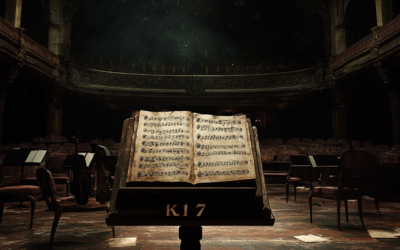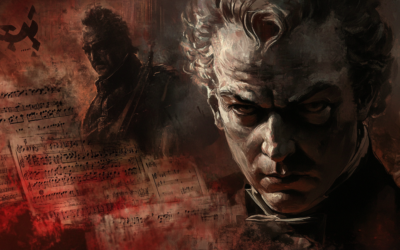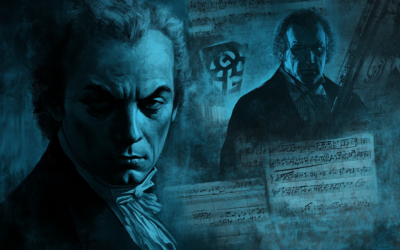Unmasking the Myth
The Cibavit eos and Mozart's Deceptive Legacy
In the realm of classical music, Wolfgang Amadeus Mozart is often portrayed as an unparalleled genius. However, a closer examination of his early works reveals a very different narrative, one in which mastery may be more illusion than reality. A striking example is the motet Cibavit eos in adipe (K. 44), which has been erroneously and romantically attributed to Mozart in various biographies.
Mozart: The Fall of the Gods
This book offers a fresh and critical look at the life of Wolfgang Amadeus Mozart, challenging the myths that have surrounded him for centuries. We strip away the romanticised image of the “natural genius” and delve into the contradictions within Mozart’s extensive biographies. Backed by nearly 2,000 meticulously sourced citations, this work invites readers to explore a deeper, more complex understanding of Mozart. Perfect for those who wish to question the traditional narrative, this biography is a must-read for serious music lovers and historians.
"They have painted a misleading portrait of a composer, as if he were profoundly skilled in counterpoint and polyphony at just fourteen years old, which is absolutely untrue."
Mozart: The Fall of the Gods
At the tender age of fourteen, Mozart faced a composition exam at the prestigious Accademia Filarmonica in Bologna—a moment that should have marked a significant turning point in his career. The exam, however, was a disaster, but he was passed nonetheless, as if the whole charade was designed to bolster a burgeoning myth.
Musicologist Hermann Abert suggested that Mozart had prepared for this farcical examination under the guidance of Giovanni Battista Martini. The reality, however, appears far less impressive. Abert claimed that Mozart had composed Cibavit eos, a supposed masterpiece that demonstrated his ability to compose in the ancient style.
The Illusion of Originality
Abert and other scholars, blinded by their own biases, asserted that Mozart approached the exam with serious preparation, producing the Cibavit, which, according to these scholars, showcased his emerging talent, impressing none other than Father Martini himself. However, a more rigorous investigation reveals that Cibavit was not an original work but a mere copy, beautifully transcribed. It unmistakably echoes the style of late Renaissance composers, a fact that becomes glaringly obvious even to the casual listener.
A Shattered Illusion
Recent discoveries have unveiled that K. 44 is a copy of an earlier work by Johann Stadlmayr rather than an original composition by Mozart. This revelation serves as a powerful testament to the precarious nature of the alleged genius of Mozart. The admiration he has received is built on a foundation of misconceptions and inaccuracies, such as the case of Cibavit, perpetuated by an uncritical acceptance of earlier biographical accounts.
The Mozart establishment and its so-called experts have confused early Renaissance music with Mozart’s compositions, revealing their ignorance of both. They have painted a misleading portrait of a composer who, at the age of fourteen, supposedly mastered counterpoint and polyphony. In reality, this is far from the truth.
Conclusion
The narrative surrounding Cibavit eos challenges us to rethink the stories we have been told and to question the foundations of the mythic genius that surrounds Mozart. This motet does not demonstrate the brilliance of Wolfgang Amadeus Mozart; instead, it exposes the superficiality of Mozart studies, highlighting how easily myths can be constructed and perpetuated in the world of classical music.
You May Also Like
Constanze Mozart’s Enduring Love
Although some have doubted her devotion, Constanze’s own words and actions illustrate a widow deeply committed to preserving Mozart’s legacy. Diaries, personal correspondence, and eyewitness testimony all challenge the notion that she neglected his memory—while the circumstances around his burial grow ever more perplexing.
A Revealing New Interview on His Thematic Catalogue
We’re excited to present a brand-new interview that challenges many of the long-held assumptions about Mozart’s Thematic Catalogue (1784–1791). Conducted by Swedish journalist Henry Grynnsten, this conversation delves into groundbreaking forensic techniques—like advanced ink analysis and digital image processing—that may change the way we view Mozart’s late works.
The Rattling Symphony: A Critical Take on K. 17
Often attributed to Mozart, the K. 17 symphony is anything but refined. Lacking orchestration and filled with gaps, it raises more questions than answers about its true authorship.
The Hidden Origins of the Salzburg Festival: A Nationalist Dream
The Salzburg Festival, far from being a mere celebration of Mozart’s genius, was born out of nationalist ambitions during a turbulent period in Austro-German history. Conceived by figures like Max Reinhardt, Heinrich Damisch, and Friedrich Gehmacher, the festival was deeply rooted in ultranationalistic ideals, transforming Mozart’s legacy into a tool for cultural dominance. The truth behind its founding has long been obscured, but the primary sources tell a different, darker story.
Mozart, Wagner, and the Nazi Myth
The Führer’s admiration for Wagner’s racially charged ideology not only influenced the policies of the Nazi regime but also reshaped the legacy of Mozart. Under National Socialism, Mozart was not celebrated as a universal genius but as a symbol of German purity and superiority. His music, stripped of its international influence, was rebranded as an expression of Aryan identity, intended to unify and inspire the German people.
Mozart, the Anschluss, and Nazi Propaganda
Following the 1938 Anschluss, the Nazi regime rebranded Mozart as the quintessential German composer, using his image to promote unity between Austria and Germany. The Salzburg Festival became a platform for Nazi propaganda, distorting Mozart’s legacy to fit their nationalistic and racial agenda.







